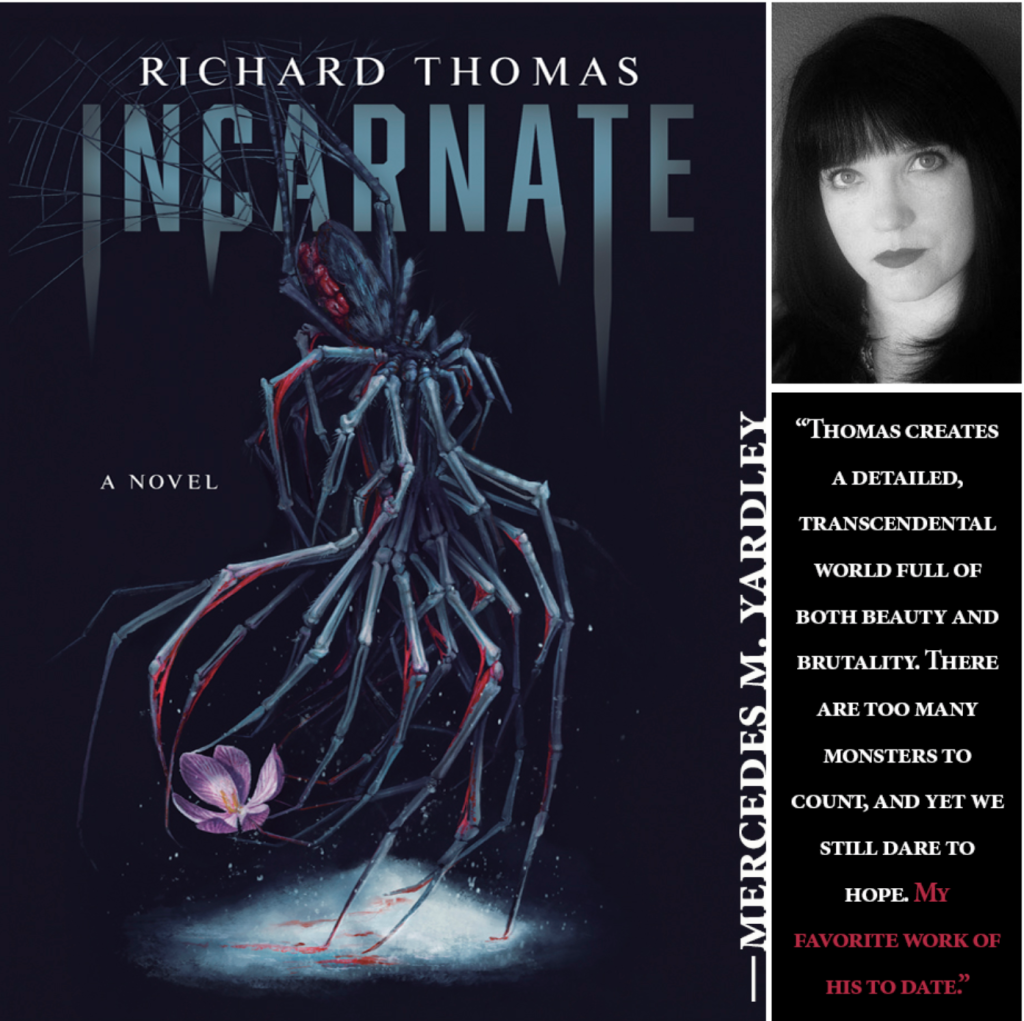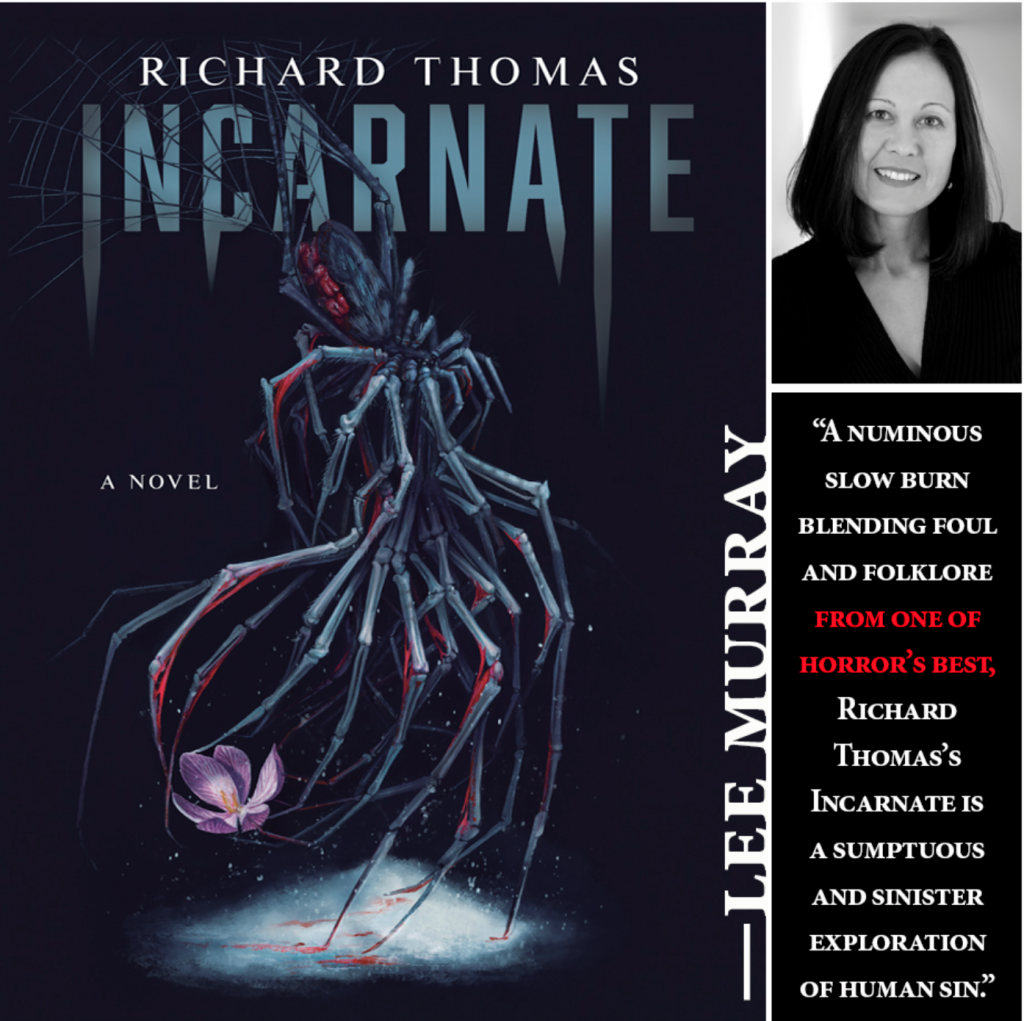Hi friends! Time to shine a light on one of my favorite speculative writers, Richard Thomas, and his upcoming novel, Incarnate (September 10, 2024): “In a frozen tundra, a sin-eater fights for redemption and absolution as monstrous creatures ravage a community already struggling to survive.” Incarnate is available now for pre-order.



Hillary: Incarnate is thick with the atmosphere of the arctic tundra. Can you elaborate on the connection between place and story in your novel? What was important to convey to build the narrative you wanted?
Richard: When I started doing research for this novel, I was fascinated with a few ideas—sin eaters, the arctic, and what happens to those isolated places (like Barrow, Alaska) where you have 60-90 days of night. What flourishes in the darkness? So the backdrop for this novel is essentially the fourth character—behind Sebastian, Mother Monster, and Kallik. Place is everything in this book—it’s emotion, it’s danger and death, it’s ritual and culture, it’s a way of life. I hired an arctic advisor, Repo Kempt, who has spent extensive time in the arctic, and with Inuit people, to help me get the details right. Of course I could build on the winters I have spent here in Chicago, but then I had to go way beyond that. It’s so dangerous out there, without adding in sin eaters, and monsters coming through a tear in reality. Nature alone is deadly. But I didn’t want to lose that wonder—the Northern Lights, the flora and fauna, the rituals and hope that tries to find a way to survive in the darkness.
Hillary: You’re known for your imagery and sensory details. What does your creative process look like for building such a rich reader experience?
Richard: For me it’s partly intent and partly leaning into something I love to do, that I see as a strength. I knew that the meals, the sin eating, the birthing of the creatures, the landscape, nature, and the beasts would all be a big part of this story. I knew there were going to be at least three scenes each for the meals, the births, and the battles. This book was divided into three acts, each act with six chapters, each chapter with four scenes of about 1,000 words. So whenever I’d write a new scene (essentially a flash fiction story) I made sure to ground it in reality, especially the first time I went to a place, or met a character. When I got done with each rough draft, I’d go back and run through it quickly for typos and flow, and then do a quick word count. If I was over 1,000—cool. If I was under, I’d go back to those moments of setting and sensory detail and expand—breathe more life into it.
I’m an expander, so it’s often the first thing I do when I edit a scene—is this deep enough, clear enough, weird enough? Have I used all five senses? Did I miss an opportunity for one of the harder, lesser used senses—sound, smell, taste, or touch. And then I kept pushing myself to go deeper, to get weirder, more original, to really show the reader something they may have never seen. And I wanted it to be immersive. If I’ve done my job, I hope to pull you into this world, hypnotize you, with this strange, dark, violent world.
Hillary: You’re an accomplished author and instructor; your craft classes and mentorship have guided numerous writers honing their craft (I can attest to this as one of them ). What sticking points in the craft do you struggle with?
Richard: Good question. I always struggle with dialogue, so I make sure when I have scenes that use a lot of it (and I tend to NOT do that) that the conversation flows, the tags are minimal (mostly “he said” or “she asked”) and then I make sure the language matches the person talking. I don’t like long monologues, so I tend to break up the dialogue with internal thought, action, setting, and sensory detail—reactions, environment, etc. I make sure to read all of my dialogue out loud, to see where I stumble, and then I fix it. Sometimes it’s just a matter of a word being -ing instead of -ed, or too many hard consonants, or an odd word choice. I’m also very aware of openings (narrative hooks and inciting incidents) as well as endings (climax, resolution, change, and denouement)—making sure that they align and have impact.
Hillary: What was your writing process like for Incarnate? Plotting? Research? Drafts? Length of time? Do share the juicy details.
Richard: So, on one hand I wrote most of it in two weeks, on another hand I took two years to write it. Let me explain. When I first started thinking about writing this book, I did a lot of research—so that means reading stories, novels, watching movies, and televisions shows. I probably read 6-10 short stories, a few books (fiction and nonfiction), and I of course re-watched The Thing, as well as the entire series of The Terror. I filled my head with images. That took a couple of years until I was in a good enough space to be able to sit down and focus and write it.
I had it as structured as I’ve ever been—three acts, six chapters, each chapter about 1,000 words. So that meant each act was about 24,000 words, for a total of 72,000 words. In some places I went a bit longer, and that added up to a book of about 78,000 words. When I sat down to finally write it, my goal was to focus on only this book—no stories, no classes, nothing else. Each day I wrote 4,000 words, each scene at about 1,000 words. I’d write out the rough, then go over it, then check it for word count, if under, expand, and then I’d move on. Each time I started a new scene, I’d go back and re-read the LAST scene. In the beginning I’d read EVERYTHING I’d written until I got a substantial chunk written, then I was off to the races. Using the rule of threes I knew I’d have one, two, three meals and then one, two, three births. Each step escalated and built on the one before it, raising the stakes, as I built to the climax of each act. Rinse and repeat. I was able to get 52,000 written in two weeks, and then I had to get back to my classes, so I just took every Friday as my writing day, and kept going until it was done—about two more months.
Along the way I stopped here and there to do research—everything from the flora and fauna of the arctic to the life that survived in the desert; customs and culture of Inuit residents, life in Alaska; and lots of recipes in great detail for the sin eating meals. When I’d gotten it where I wanted it to be, I asked my daughter to listen to the ending—she’d talked with me about the book every night on our walks around the neighborhood—and when I saw her tearing up, I knew that the hope and impact at the end had landed. I’d done my job. I think it’s some of my best work to date—maximalist setting that builds on isolation and cosmic horror, elements of hope woven in to make the trip and brutality worth it.
Richard Thomas is the award-winning author of nine books. These include the novels Incarnate, Disintegration, Breaker, and Transubstantiate; the collections Spontaneous Human Combustion, Tribulations, Staring into the Abyss, and Herniated Roots; and a novella, collected in The Soul Standard. Thomas has been nominated for Bram Stoker, Shirley Jackson, ITW Thriller, and Audie awards. He has more than 175 stories in print. For more information visit www.whatdoesnotkillme.com.

Leave a comment